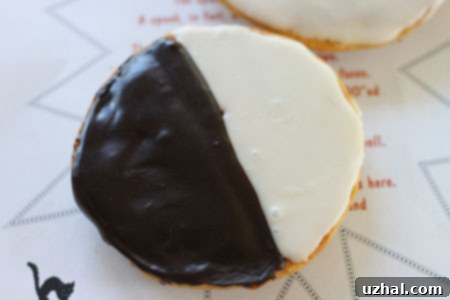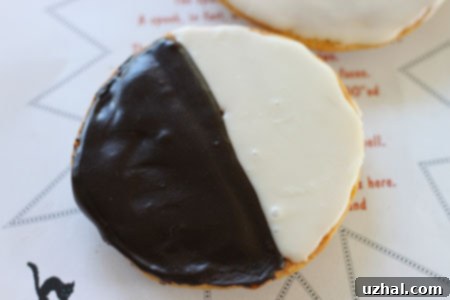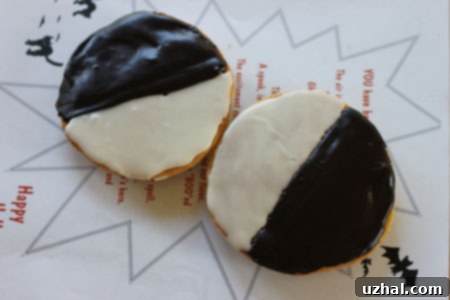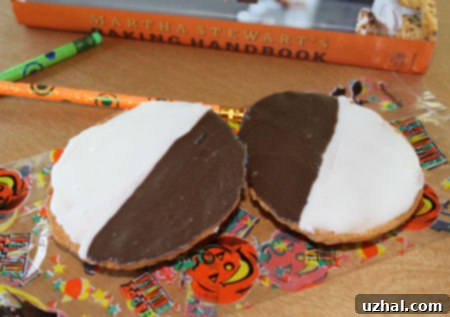The Ultimate Guide to Black and White Cookies: Classic Recipes and My Favorite Buttermilk Version
There’s a special place in my heart, and undoubtedly in the hearts of many, for the iconic Black and White Cookie. A true New York deli staple, these distinctive treats offer a delightful contrast of flavors and textures, with their soft, cake-like base crowned by a flawless half-vanilla, half-chocolate frosting. Over the years, I’ve embarked on a delicious quest to find the ultimate Black and White Cookie recipe, experimenting with various acclaimed versions from culinary giants like Epicurious, Martha Stewart, Baked Bakery, and even Salon.com. While each recipe brought its unique charm to the table, my heart consistently returns to the ones made with buttermilk, a technique I first encountered in a Gourmet magazine recipe. These particular cookies capture the perfect balance of a tender, slightly cakey texture and a nuanced flavor profile that truly sets them apart.
What truly elevates my favorite Black and White Cookies is their distinctive texture. Unlike some recipes that yield a denser or overly crumbly result, these boast a delightful cakiness that remains moist and incredibly flavorful. The vanilla notes are pronounced and comforting, beautifully complemented by a subtle hint of lemon that brightens the overall taste without overpowering it. This balance makes them incredibly appealing to all palates, including younger ones. As for the signature icing, the recipe I’m sharing here delivers a consistently smooth and perfectly divided frosting that adheres beautifully to the cookie. However, I’m always eager to discover new techniques or ingredient combinations, so if you have a secret to an even better icing, please share!
Exploring the World of Black and White Cookie Recipes
My journey to find the perfect Black and White Cookie involved trying several popular and highly-rated recipes. Each offered a unique interpretation of this classic, highlighting different aspects of its potential. Below, I detail my experiences with some of these notable variations, offering insights into their characteristics and why my preferred buttermilk-based recipe ultimately stands out.
Gourmet Black and White Cookies (Epicurious)
|
My absolute favorite Black and White cookie recipe to date! These cookies deliver a tender, slightly cakier texture that is less prone to crumbling compared to many other versions. The inclusion of buttermilk contributes significantly to their exceptional moistness and delightful flavor profile. They offer a balanced vanilla taste with just a hint of lemon, making them widely appealing and particularly kid-friendly. This recipe truly embodies the ideal Black and White cookie experience for me. The careful balance of ingredients ensures a soft, tender crumb that melts in your mouth, making each bite a truly satisfying experience. |
Baked Explorations Black and White Cookies
|
These cookies from Baked Explorations are undoubtedly very good. They struck a fantastic balance of being moist without venturing into overly cakey territory. What truly impressed me was their inherent lightness, a characteristic often sought after in a classic Black and White. The lemony flavor was quite prominent in this version, offering a zesty brightness that many lemon enthusiasts would adore. While not my top favorite, they certainly delivered a delicious and authentic Black and White experience, showcasing a different yet equally enjoyable approach to the cookie’s flavor profile. The slight tang from the lemon zest provided a refreshing contrast to the sweet frosting, making them a memorable treat. |
Salon.com Black and White Cookie Recipe
|
The Salon.com Black and White Cookie recipe produced a cookie that tasted remarkably similar to the ones you’d find in a traditional New York deli. They possessed that quintessential crumbly, light texture that is often associated with the classic version. My mother, a connoisseur of these cookies, absolutely loved them, which is a testament to their authentic taste. However, after trying other recipes that incorporate more butter, I found myself leaning towards those for their richer mouthfeel. While the Salon.com version truly captured the essence of a deli Black and White with its light and airy crumb, I personally prefer a slightly more decadent and buttery base in my ideal cookie. It’s a fantastic recipe for those who prioritize the light, traditional texture. |
Martha Stewart Baking Handbook Recipe
|
Martha Stewart’s take on the Black and White cookie resulted in a notably richer and denser treat, primarily due to a higher fat content compared to the other recipes I tested. These cookies were incredibly filling and felt quite substantial. Because of their richness and density, I believe they would be absolutely perfect when made as “minis.” In their regular size, they tend to be almost too heavy, making it difficult to enjoy more than one. If you’re looking for a truly indulgent and satisfying cookie that feels more like a small cake, this recipe is an excellent choice. It offers a luxurious experience, albeit one that is perhaps best enjoyed in moderation or scaled down in size. |
My exploration has taught me that while the core concept of a Black and White cookie remains the same, subtle changes in ratios and ingredients can lead to vastly different outcomes in texture and flavor. The buttermilk in my favorite recipe is truly a game-changer, imparting a tender crumb and a slight tang that complements the sweet frostings beautifully.
The Origins and Enduring Appeal of Black and White Cookies
The Black and White cookie isn’t just a dessert; it’s a cultural icon, particularly in New York. Its origins are somewhat debated, but most food historians trace its lineage back to the German-American bakeries of New York in the early 20th century. Some suggest it’s a variation of a “half-moon cookie” popular in upstate New York, which often features a more cake-like base and a mix of vanilla and chocolate frostings. Regardless of its precise inception, the Black and White quickly became a staple in delicatessens and bakeries across the city, earning its place as a quintessential New York treat.
The cookie’s simple yet striking appearance – a perfectly round, slightly domed cake-like base divided equally by opaque vanilla and dark chocolate frosting – makes it instantly recognizable. Its enduring appeal lies in this duality: the visual contrast, the textural harmony of soft cake and smooth icing, and the flavor combination that satisfies both vanilla and chocolate lovers simultaneously. It’s a cookie that promises a little bit of everything, making it a democratic choice for any sweet craving. Famous pop culture references, like Jerry Seinfeld’s impassioned monologue about “looking to the cookie” for racial harmony, only cemented its status as more than just a dessert; it’s a symbol of New York’s diverse yet unified spirit.
The Anatomy of a Perfect Black and White Cookie
Achieving the perfect Black and White cookie involves mastering a few key components:
- The Cookie Base: The foundation should be soft, tender, and slightly cake-like, not thin and crisp like a typical cookie. It needs enough structure to hold the generous layers of frosting without crumbling, but also a moistness that prevents it from being dry. The ideal flavor balance often includes a dominant vanilla note, sometimes brightened by a hint of lemon zest, which adds a lovely, subtle complexity. The buttermilk in my preferred recipe is crucial here, contributing to both the tender texture and a slight tang that elevates the overall flavor.
- The Icing: This is where the “black and white” magic truly happens. There are two distinct frostings: a pristine white vanilla and a rich, dark chocolate. Both should be opaque, smooth, and have a consistency that is thick enough to spread cleanly without running, but still soft enough to yield a glossy, even finish. The key is to apply them neatly, creating a clear, straight line down the middle of the cookie. Achieving this perfect division is part of the cookie’s charm and a testament to the baker’s skill.
- Flavor Harmony: The subtle lemon in the cookie base provides a refreshing counterpoint to the sweetness of the frostings, ensuring the cookie is not overly sugary. The vanilla frosting should be pure and bright, while the chocolate side should offer a deep, rich cocoa flavor. When eaten together, the combination creates a delightful symphony of tastes and textures that is truly unique.
Mastering these elements is what transforms a good Black and White cookie into an unforgettable one, an experience that echoes the bustling energy and sweet traditions of New York City.
Recipe

Favorite Black and White Cookies
Anna
Pin Recipe
Ingredients
For the Cookies:
- 1 ¼ cups all-purpose flour (160 grams)
- ½ teaspoon baking soda
- ½ teaspoon salt
- 5 ½ tablespoons unsalted butter softened (50 grams), essential for a tender crumb
- ½ cup granulated sugar ( 100 grams)
- 1 teaspoon fresh lemon zest or a tiny dash of lemon oil (for that essential hint of citrus)
- 1 teaspoon vanilla extract (pure vanilla for best flavor)
- 1 large egg at room temperature (helps with emulsification and texture)
- ⅓ cup buttermilk or equivalent buttermilk powder + water (the secret to tenderness and flavor)
For the Frosting:
- 1 ¾ cup plus 2 tablespoons powdered sugar (240 grams), sifted for smoothness
- 2 to 3 tablespoons whole milk plus more as needed (for desired consistency)
- 1 ½ tablespoons heavy cream (adds richness to the frosting)
- 1 teaspoon of corn syrup (for gloss and to prevent crystallization)
- 1 teaspoon pure vanilla extract (for the white frosting)
- ¼ cup plus 1 tablespoon unsweetened cocoa powder (for the chocolate frosting)
Instructions
-
Preheat your oven to 350°F (175°C). Line a large baking sheet with parchment paper to prevent sticking and ensure even baking.
-
In a medium bowl, whisk together the all-purpose flour, baking soda, and salt. Make sure these dry ingredients are thoroughly combined to ensure proper leavening and seasoning throughout the cookies. Set this mixture aside.
-
In a separate large bowl, using a handheld electric mixer, beat the softened unsalted butter and granulated sugar together until the mixture is light in color and fluffy in texture. This creaming process incorporates air, contributing to the cakey texture of the cookies. Next, beat in the fresh lemon zest and vanilla extract until well combined and fragrant. Finally, add the large egg, beating until it is fully incorporated into the butter mixture, scraping down the sides of the bowl as needed.
-
Gradually add the reserved flour mixture and the buttermilk (or reconstituted buttermilk powder) to the wet ingredients, alternating between the two. Begin and end with the flour mixture. Mix by hand with a spatula or on low speed with the electric mixer just until a smooth batter forms. Be careful not to overmix, as this can lead to tough cookies.
-
Drop ¼ cup portions of batter onto the prepared baking sheet, spacing them approximately 2 inches apart to allow for spreading. These generous scoops will result in classic-sized cookies. Bake in the preheated oven for 15 to 17 minutes, or until the tops are beautifully puffed and a pale golden color. The cookies should spring back gently when lightly touched, indicating they are cooked through. Avoid overbaking to maintain their moist, cake-like consistency.
-
Once baked, transfer the cookies immediately to a wire rack using a metal spatula. For quicker cooling, you can chill them for about 5 minutes, or simply allow them to cool completely at room temperature before frosting. Ensure they are fully cooled before proceeding to the next step to prevent the icing from melting.
-
While the cookies cool, prepare the classic Black & White Icing. In a large bowl, whisk together the sifted powdered sugar, 2-3 tablespoons of whole milk, heavy cream, corn syrup, and 1 teaspoon of vanilla extract until completely smooth. The corn syrup is key for that signature glossy finish and to prevent the icing from crystallizing. Adjust milk gradually until you reach a consistency that is spreadable but not too thin. Measure out approximately ⅓ cup of this white vanilla frosting and transfer it to a separate small bowl.
-
To the ⅓ cup of vanilla frosting you just separated, add the unsweetened cocoa powder and about ½ teaspoon of water. Stir vigorously until you achieve a smooth, rich chocolate frosting. If the chocolate frosting appears too thick, thin it with a tiny amount of additional water or milk, a few drops at a time, until it matches the consistency of the vanilla frosting. This ensures both frostings spread evenly.
-
Transfer both the vanilla and chocolate frostings into separate disposable decorating bags. You won’t need a fancy decorating tip; just snip off a small corner (about ¼ inch) from the tip of each bag when you’re ready to apply the frosting. Working with one cookie at a time, pipe or spread a half-moon of vanilla frosting onto one side of the cooled cookie, then immediately apply a half-moon of chocolate frosting to the other side, meeting perfectly in the middle. The goal is a clean, distinct line between the two flavors. Allow the frosting to set for at least 30 minutes at room temperature before stacking or serving.
-
This recipe typically yields about 8 to 10 generously sized Black and White Cookies. I usually achieve 8 perfect cookies from this batch.
Tips for Perfect Icing and Foolproof Black and White Cookies
Crafting the iconic two-tone frosting for Black and White cookies requires a bit of finesse. Here are some key tips to ensure your icing is as beautiful as it is delicious:
- Sift Your Powdered Sugar: This is crucial for a lump-free, silky-smooth frosting. Don’t skip this step, especially for the vanilla frosting where smoothness is paramount.
- Achieve the Right Consistency: The icing should be thick enough to hold its shape and not run off the cookie, but thin enough to spread smoothly and create a glossy finish. Add milk a tablespoon at a time until you reach this ideal consistency. It should slowly fall from a spoon, not drip rapidly.
- Corn Syrup for Shine: The addition of corn syrup isn’t just for sweetness; it contributes to that beautiful, almost mirror-like sheen characteristic of authentic Black and White cookies, and helps prevent the sugar from crystallizing.
- Matching Consistencies: Ensure both your vanilla and chocolate frostings have very similar consistencies. This makes them easier to apply evenly and helps create that crisp dividing line. If one is thicker than the other, adjust with a few drops of milk or water.
- Application Techniques: While piping bags (with a small corner snipped off) offer the most control for a clean half-moon, you can also use a small offset spatula or a butter knife. Start with the vanilla side, allowing it to set for a minute or two, then carefully apply the chocolate. Some bakers prefer to chill the cookies briefly after the first half is applied to make the second half easier to manage.
- Allow to Set: Patience is a virtue here. Give your frosted cookies ample time (at least 30 minutes to an hour, or even longer in humid conditions) for the icing to set and harden slightly. This prevents smudging when handling or stacking.
For the cookie base itself, a few extra pointers can make all the difference: make sure your butter and egg are at room temperature for better emulsion, avoid overmixing the batter once the flour is added, and watch your cookies carefully in the oven to prevent overbaking, which can lead to a dry crumb.
Creative Variations and Customizations
While the classic Black and White cookie is perfect as is, there’s always room for a little creativity! Here are some ideas to customize your cookies:
- Mini Black and Whites: For parties or a less indulgent treat, spoon out smaller portions of batter (about 1-2 tablespoons) to create delightful mini versions. Adjust baking time accordingly. Martha Stewart’s denser recipe is excellent for these!
- Flavor Enhancements: Experiment with different extracts. A touch of almond extract in the cookie base or vanilla frosting, or even orange zest for a citrusy twist, can add new dimensions.
- Holiday Themes: Change the frosting colors for holidays! Think orange and black for Halloween, red and white for Valentine’s Day, or green and white for St. Patrick’s Day. Food coloring can easily transform the white frosting.
- Gluten-Free Options: With the increasing availability of good gluten-free all-purpose flour blends, you can adapt this recipe to cater to dietary needs. Look for blends designed for baking.
- Chocolate Chip Base: Fold in a handful of mini chocolate chips into the cookie batter for an extra burst of chocolate in the cake base itself.
No matter how you choose to make them, Black and White cookies are a timeless treat that brings joy with every bite. I encourage you to try my favorite buttermilk recipe and discover the magic of these iconic cookies for yourself!
- Black Bottom Cupcakes
- Old Fashioned Black Walnut Pound Cake
- Pudding Mix Black and White Cookies
- Mini Black Bottom Cupcakes
- Easy Black and Orange Cookies




